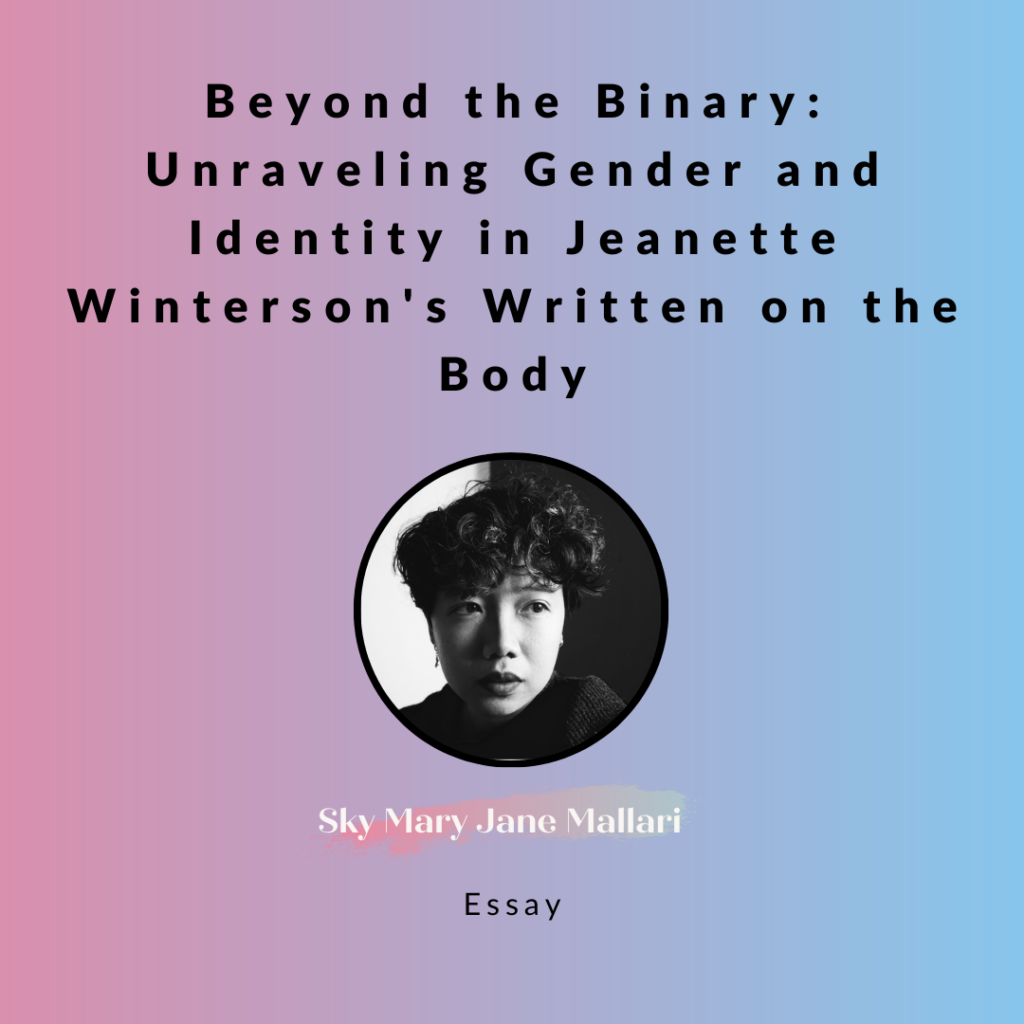
I remember reading this novel in one of my university classes, at a time when including queer novels in course reading lists for the English Literature curriculum in my campus was a rarity. It’s a novel that exposes the reader to the powerful prose of Winterson, that not only explores the complexities of love, sex, relationships, and illicit affairs but also, most importantly, the question of gender.
The enigmatic narrator remained unnamed, leaving readers suspended in the realm of conjecture regarding the narrator’s gender. Yet, inexplicably, the collective assumption is inclined toward the narrator’s lesbianism.
Was this association merely a consequence of the author’s persona? Or did it stem from the deep-seated, socially ingrained gender constructs that have permeated our collective consciousness? Could it be attributed to an innate curiosity about whether a lesbian author would craft a tale of such intimacy? Was it the subtle autobiographical undertones that guided our assumptions? Could it even be that our perception of lesbian sexuality, shaped by societal preconceptions, colored our interpretation of the narrator’s gender?
The real question, however, is what the unnamed narrator represents, and how did Jeanette Winterson employ the absence of a name, as a means of self-representation and critical exposure of society’s ingrained gender binary concepts.
Winterson’s novel captivates readers with its central themes of sexuality, love, and loss, offering a form of resistance and empowerment through the unnamed narrator. By withholding the narrator’s gender, Winterson challenges our ingrained assumptions and expectations. The societal coding of gender binary signifiers shapes our perception, making it difficult to imagine a narrator outside the traditional norms. Our assumption that the narrator is a lesbian arises from a combination of factors, including the association of the author with the story, the potential autobiographical nature of the narrative, and the description of sexual encounters that align with common perceptions of lesbian intimacy.
The question of whether to identify the narrator’s gender reveals our societal tendency to analyze and categorize individuals based on gender binary signifiers. We are taught to associate certain characteristics, behaviors, and expectations with specific genders from an early age. This process becomes so deeply ingrained that we instinctively search for these signifiers, even when they are not explicitly provided. Winterson’s decision to keep the narrator’s gender ambiguous challenges this ingrained way of thinking, forcing us to confront the limitations of our assumptions.
Furthermore, Written on the Body examines the tension between historical verifiability, memory, fantasy, and imagination. It raises questions about the reliability of self-representation and the significance of names as markers of identity. Winterson uses this tension to experiment with how sexuality, love, and loss can be represented and understood. The absence of a fixed gender identity for the narrator emphasizes the power of representation and challenges our expectations about how a lesbian author should write a lesbian text.
Winterson’s narrative also highlights the complex relationship between identity and representation. Rather than relying on stable referents or practices to define bodies as lesbian, the story emphasizes the fluidity and interconnectedness of identity and representation. The author explores the claims to knowledge made by the presence or absence of names, pushing against the legalistic imperative of proof and instead emphasizing the significance and relational nature of identity within and among texts.
Through an intertextual reading, we can better understand Winterson’s refusal of patriarchal naming and the identities it imposes. The unnamed narrator challenges the intelligibility of the body with normative discourses of identity. Winterson’s choice to decline a name disrupts heterosexist claims to knowledge. The absence of a name prompts us to question the significance of this absence and how it signifies within the context of the narrative.
Jeanette Winterson’s Written on the Body offers a thought-provoking exploration of sexuality, love, and loss through an unnamed narrator. By deliberately withholding the narrator’s gender, Winterson challenges our societal expectations and prompts us to question the influence of gender binary signifiers. The absence of a fixed gender identity highlights the power of representation and invites us to reconsider how identity and truth are constructed through the body. As readers, we are encouraged to question our assumptions and embrace human experiences’ fluidity and complexity beyond traditional norms.
by Sky Mary Jane Mallari
Resources

Winterson, Jeanette, Written on the Body. Vintage. 1994. https://www.amazon.com/Written-Body-Jeanette-Winterson/dp/0679744479
Gilmore, Leigh. The Limits of Autobiography: Trauma and Testimony. Cornell University Press, 2001. JSTOR, http://www.jstor.org/stable/10.7591/j.ctv3s8p46.
Öztop Haner, Sezgi. “The Breakdown of Gender Binaries through the Transgendered Subject in Angela Carter’s The Passion of New Eve and Jeanette Winterson’s Written on the Body.” Sosyal Araştırmalar, vol. 12, no. 67, 2019, pp. 98-100. ISSN: 1307-9581. https://www.sosyalarastirmalar.com/articles/the-breakdown-of-gender-binaries-through-the-transgendered-subject-in-angela-carters-the-passion-of-new-eve-and-jeanette.pdf
French, Jana L. “‘I’m Telling You Stories…. Trust Me’: Gender, Desire, and Identity in Jeanette Winterson’s Historical Fantasies.” Journal of the Fantastic in the Arts, vol. 10, no. 3 (39), 1999, pp. 231–52. JSTOR, http://www.jstor.org/stable/43308390



